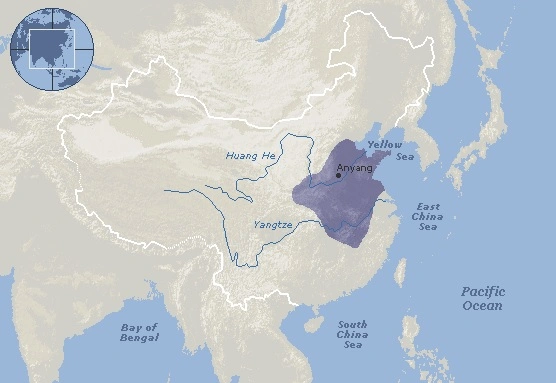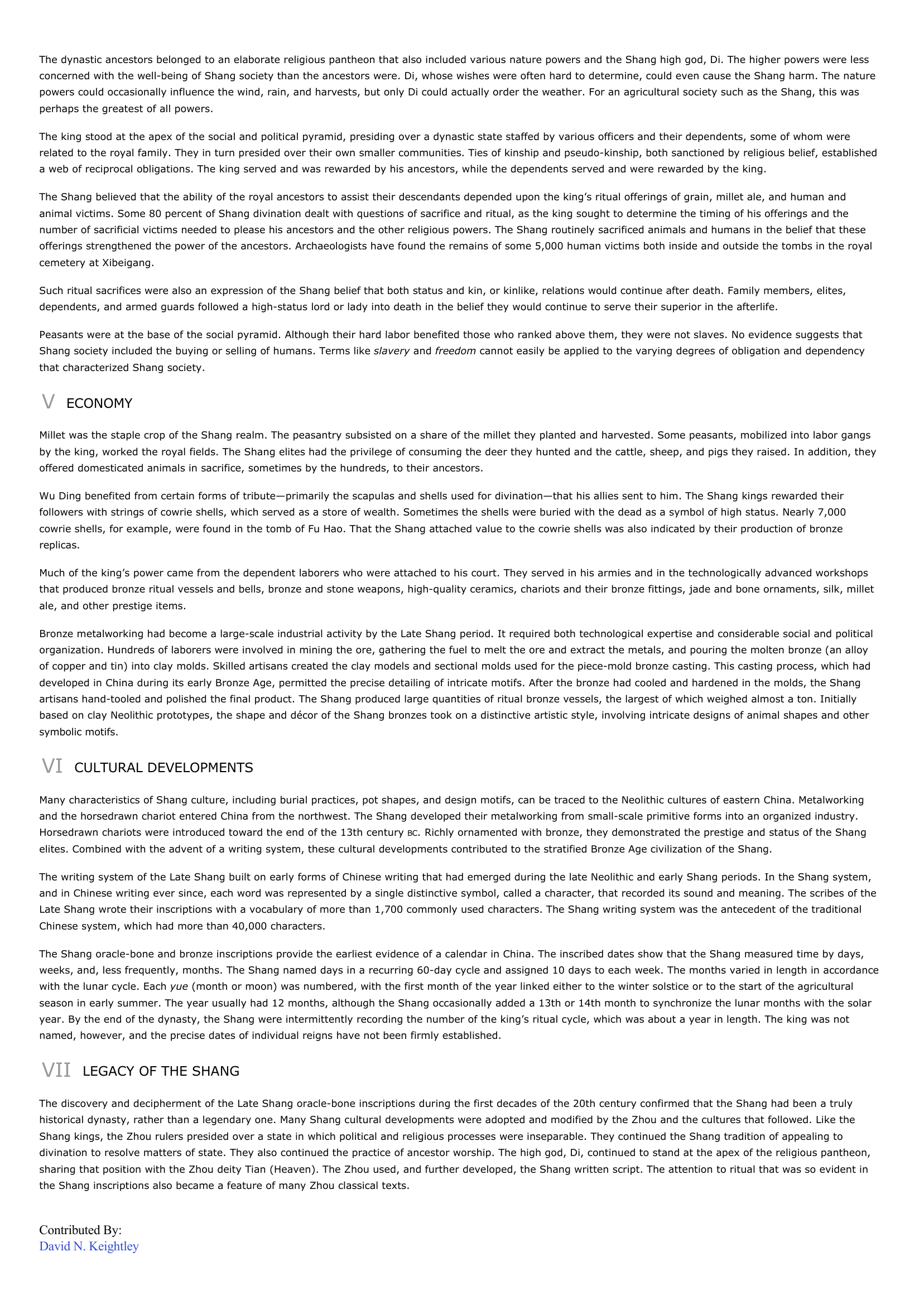Shang Dynasty - History.
Publié le 02/05/2013

Extrait du document


«
The dynastic ancestors belonged to an elaborate religious pantheon that also included various nature powers and the Shang high god, Di.
The higher powers were lessconcerned with the well-being of Shang society than the ancestors were.
Di, whose wishes were often hard to determine, could even cause the Shang harm.
The naturepowers could occasionally influence the wind, rain, and harvests, but only Di could actually order the weather.
For an agricultural society such as the Shang, this wasperhaps the greatest of all powers.
The king stood at the apex of the social and political pyramid, presiding over a dynastic state staffed by various officers and their dependents, some of whom wererelated to the royal family.
They in turn presided over their own smaller communities.
Ties of kinship and pseudo-kinship, both sanctioned by religious belief, establisheda web of reciprocal obligations.
The king served and was rewarded by his ancestors, while the dependents served and were rewarded by the king.
The Shang believed that the ability of the royal ancestors to assist their descendants depended upon the king’s ritual offerings of grain, millet ale, and human andanimal victims.
Some 80 percent of Shang divination dealt with questions of sacrifice and ritual, as the king sought to determine the timing of his offerings and thenumber of sacrificial victims needed to please his ancestors and the other religious powers.
The Shang routinely sacrificed animals and humans in the belief that theseofferings strengthened the power of the ancestors.
Archaeologists have found the remains of some 5,000 human victims both inside and outside the tombs in the royalcemetery at Xibeigang.
Such ritual sacrifices were also an expression of the Shang belief that both status and kin, or kinlike, relations would continue after death.
Family members, elites,dependents, and armed guards followed a high-status lord or lady into death in the belief they would continue to serve their superior in the afterlife.
Peasants were at the base of the social pyramid.
Although their hard labor benefited those who ranked above them, they were not slaves.
No evidence suggests thatShang society included the buying or selling of humans.
Terms like slavery and freedom cannot easily be applied to the varying degrees of obligation and dependency that characterized Shang society.
V ECONOMY
Millet was the staple crop of the Shang realm.
The peasantry subsisted on a share of the millet they planted and harvested.
Some peasants, mobilized into labor gangsby the king, worked the royal fields.
The Shang elites had the privilege of consuming the deer they hunted and the cattle, sheep, and pigs they raised.
In addition, theyoffered domesticated animals in sacrifice, sometimes by the hundreds, to their ancestors.
Wu Ding benefited from certain forms of tribute—primarily the scapulas and shells used for divination—that his allies sent to him.
The Shang kings rewarded theirfollowers with strings of cowrie shells, which served as a store of wealth.
Sometimes the shells were buried with the dead as a symbol of high status.
Nearly 7,000cowrie shells, for example, were found in the tomb of Fu Hao.
That the Shang attached value to the cowrie shells was also indicated by their production of bronzereplicas.
Much of the king’s power came from the dependent laborers who were attached to his court.
They served in his armies and in the technologically advanced workshopsthat produced bronze ritual vessels and bells, bronze and stone weapons, high-quality ceramics, chariots and their bronze fittings, jade and bone ornaments, silk, milletale, and other prestige items.
Bronze metalworking had become a large-scale industrial activity by the Late Shang period.
It required both technological expertise and considerable social and politicalorganization.
Hundreds of laborers were involved in mining the ore, gathering the fuel to melt the ore and extract the metals, and pouring the molten bronze (an alloyof copper and tin) into clay molds.
Skilled artisans created the clay models and sectional molds used for the piece-mold bronze casting.
This casting process, which haddeveloped in China during its early Bronze Age, permitted the precise detailing of intricate motifs.
After the bronze had cooled and hardened in the molds, the Shangartisans hand-tooled and polished the final product.
The Shang produced large quantities of ritual bronze vessels, the largest of which weighed almost a ton.
Initiallybased on clay Neolithic prototypes, the shape and décor of the Shang bronzes took on a distinctive artistic style, involving intricate designs of animal shapes and othersymbolic motifs.
VI CULTURAL DEVELOPMENTS
Many characteristics of Shang culture, including burial practices, pot shapes, and design motifs, can be traced to the Neolithic cultures of eastern China.
Metalworkingand the horsedrawn chariot entered China from the northwest.
The Shang developed their metalworking from small-scale primitive forms into an organized industry.Horsedrawn chariots were introduced toward the end of the 13th century BC.
Richly ornamented with bronze, they demonstrated the prestige and status of the Shang elites.
Combined with the advent of a writing system, these cultural developments contributed to the stratified Bronze Age civilization of the Shang.
The writing system of the Late Shang built on early forms of Chinese writing that had emerged during the late Neolithic and early Shang periods.
In the Shang system,and in Chinese writing ever since, each word was represented by a single distinctive symbol, called a character, that recorded its sound and meaning.
The scribes of theLate Shang wrote their inscriptions with a vocabulary of more than 1,700 commonly used characters.
The Shang writing system was the antecedent of the traditionalChinese system, which had more than 40,000 characters.
The Shang oracle-bone and bronze inscriptions provide the earliest evidence of a calendar in China.
The inscribed dates show that the Shang measured time by days,weeks, and, less frequently, months.
The Shang named days in a recurring 60-day cycle and assigned 10 days to each week.
The months varied in length in accordancewith the lunar cycle.
Each yue (month or moon) was numbered, with the first month of the year linked either to the winter solstice or to the start of the agricultural season in early summer.
The year usually had 12 months, although the Shang occasionally added a 13th or 14th month to synchronize the lunar months with the solaryear.
By the end of the dynasty, the Shang were intermittently recording the number of the king’s ritual cycle, which was about a year in length.
The king was notnamed, however, and the precise dates of individual reigns have not been firmly established.
VII LEGACY OF THE SHANG
The discovery and decipherment of the Late Shang oracle-bone inscriptions during the first decades of the 20th century confirmed that the Shang had been a trulyhistorical dynasty, rather than a legendary one.
Many Shang cultural developments were adopted and modified by the Zhou and the cultures that followed.
Like theShang kings, the Zhou rulers presided over a state in which political and religious processes were inseparable.
They continued the Shang tradition of appealing todivination to resolve matters of state.
They also continued the practice of ancestor worship.
The high god, Di, continued to stand at the apex of the religious pantheon,sharing that position with the Zhou deity Tian (Heaven).
The Zhou used, and further developed, the Shang written script.
The attention to ritual that was so evident inthe Shang inscriptions also became a feature of many Zhou classical texts.
Contributed By:David N.
Keightley.
»
↓↓↓ APERÇU DU DOCUMENT ↓↓↓
Liens utiles
- Shang Dynasty - history.
- Qing Dynasty - history.
- Han Dynasty - history.
- Qin Dynasty - history.
- Han Dynasty - history.










